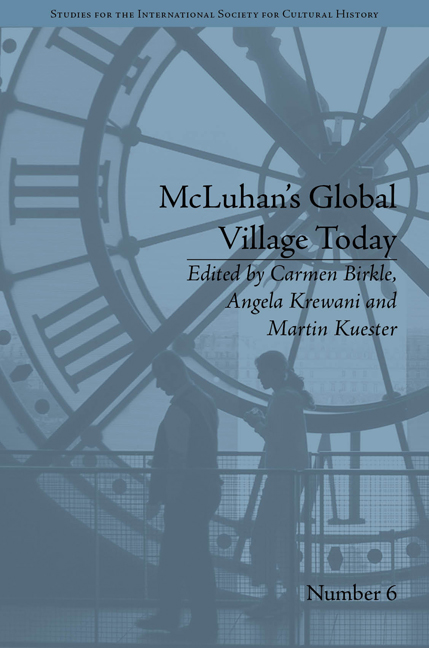Book contents
- Frontmatter
- CONTENTS
- List of Contributors
- List of Figures
- McLuhan's Global Village Today: An Introduction
- Part I McLuhan and Media Theory
- Part II McLuhan and Literature
- Part III McLuhan and Technical Media
- 11 Radio Voices: Reflections on McLuhan's Tribal Drum
- 12 McLuhan's Paradigms and Schafer's ‘Soundscape’: Parallels, Influences, Envelopes, Shifts
- 13 Literary Modernists, Canadian Moviegoers and the New Yorker Lobby: Reframing McLuhan in Annie Hall
- 14 The Animated Medium is the Animated Message (?): Reading Animated Moving Pictures with Marshall McLuhan
- 15 Marshall McLuhan and the Emergence of American Television Theory
- 16 ‘The Medium in Your Pocket’: A McLuhanian Approach to New Media
- Notes
- Index
14 - The Animated Medium is the Animated Message (?): Reading Animated Moving Pictures with Marshall McLuhan
from Part III - McLuhan and Technical Media
- Frontmatter
- CONTENTS
- List of Contributors
- List of Figures
- McLuhan's Global Village Today: An Introduction
- Part I McLuhan and Media Theory
- Part II McLuhan and Literature
- Part III McLuhan and Technical Media
- 11 Radio Voices: Reflections on McLuhan's Tribal Drum
- 12 McLuhan's Paradigms and Schafer's ‘Soundscape’: Parallels, Influences, Envelopes, Shifts
- 13 Literary Modernists, Canadian Moviegoers and the New Yorker Lobby: Reframing McLuhan in Annie Hall
- 14 The Animated Medium is the Animated Message (?): Reading Animated Moving Pictures with Marshall McLuhan
- 15 Marshall McLuhan and the Emergence of American Television Theory
- 16 ‘The Medium in Your Pocket’: A McLuhanian Approach to New Media
- Notes
- Index
Summary
My topic in this essay is the animated moving picture, particularly in film. I think there lies a benefit in reading animated moving pictures with Marshall McLuhan's theories in mind because of the specific media-based quality of these theories. Animated films reflect the very regime of film, which is the visualization of motion. On the one hand, every film obtains a quality of animation because every movement in film is an optical illusion. On the other hand, there is a wide range of movies whose very aesthetic quality lies in their appearing to be ‘artificial’. Animation in its semantic variance unifies the possibility of ‘animating’ something by ‘giving it a soul’ with that more mundane aspect of making it appear live on screen by means of colours and lines, digital algorithm or objects and also sound effects.
First of all I want to explain why I chose the topic of animation. Regarding the latest films that have appeared on the screen, we can see many of them ‘blurring boundaries’ between animation and so-called live-action movies. Animated movies influence their audience emotionally and even intellectually in the same way live-action movies do. An example, albeit a rather clichéd one, would be Bambi, where the audience is confronted with the moving death of a ‘drawn’ character.
- Type
- Chapter
- Information
- McLuhan's Global Village TodayTransatlantic Perspectives, pp. 169 - 176Publisher: Pickering & ChattoFirst published in: 2014



